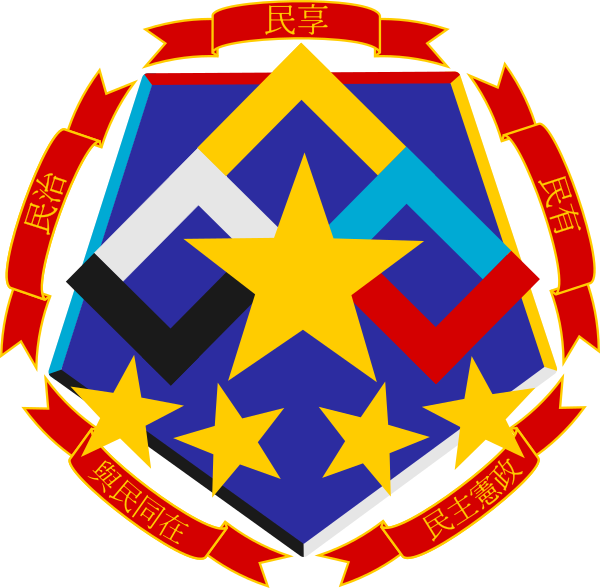Deviation Actions
Description
The Five Fives is the primary crest and logo of the moderate-right Chinese People’s Party, one of the two successors of the Communist Party and current leader of its government. While the party’s ideology and iconography were fluid through the emergency period of the ‘40s, by the ‘50s the party had firmly adopted the ideology of Modern Chinese Republicanism. The crest was designed to show the synthesis of their ideals and plans for China’s future.
The Five Races: The center of the crest presents the five bands of the original Chinese republican flag, bent into an arrow pointing upwards towards heaven and progress. While the People’s Party does not believe the existence of five distinct races in China, the pattern does express their belief in multiculturalism and civic nationalism.
The Five Classes: The yellow stars of China’s current flag, adopted under the Communist Party, are also presented in the center. Rather than representing the Communist Party, the central star represents the political class of China. The other four stars represent the technical class, cultural class, working class and the bourgeoise. While the political class is above the other classes, it is only though the support of the other classes that the political classes can guide China to a bright future.
The Five Principles: The Five Principles were first presented in Dr. Guowei Ni’s The Third Republic, are represented with the pentagonal keystone that makes up the body of crest. The Five Principles are as follows:
-The Mountain Principle: Fundamental changes to states and systems are prone to create crises. Even peaceful reform, if deep enough, can upset the complex interdependencies that underlie modern societies. Thus, in the Chinese context, the Mountain Principle calls for the preservation of the capitalist system.
-The Katsura Principle: Authoritarian and democratic societies are best suited for handling different forms of crises. To preserve democracy, it can be necessary to adopt temporary authoritarian measures.
-The Tortoise Principle: Since improperly handling a crisis could lead to an unwanted shift from democracy to authoritarianism, political leaders must be careful and steady when making major political decisions.
-The Silversmith Principle: Like a silversmith at his craft, citizens must carefully select and shape their leaders, and dispose of those who show impurity.
-The Lantern Principle: As a stable democracy, China is obligated to spread its beacon of hope through the world by being a good neighbor and an ally to the oppressed.
The Five Elements: The colors of five elements of Fire, Earth, Metal, Water and Wood ring the keystone. These elements represent the party’s commitment to preserving nature and Chinese heritage.
The Five Pledges: The ribbons surrounding the crest are embroided with the Five Pledges of the People’s Party, that the People’s party is For the People, By the People, Of the People, With the People, and Within (or among) the People. These pledges affirm the Party’s commitment to democracy, participation by lay members in the party, and desire to include citizens from all walks of life.
--------------------------------------------------------------------
From the shining mega-cities of the African coast, to the flooded streets of Old Miami. From the packed arcologies of China, to the bleak burning fields of Venezuela. From the vigorous debate of commune meeting halls in Buenos Aires, to the hushed whispers of secret party meetings in Munich. From the singing in the historicist concert halls of Montreal, to the screams over the burning slums of Moscow. From crowds of protesters in London, New Delhi, and Oran, to lonely miners on the Moon. All of it lives, all of it breathes, and all of it will one day die. All under the same twinkling light of the stars.
Our Fathers' Stars.

















![Holy Russian Empire [Taboritsky] [TNO]](https://images-wixmp-ed30a86b8c4ca887773594c2.wixmp.com/f/ff0b1107-feed-4b92-a9c2-e7c4aff0ea1d/deejp1q-dbe2a775-1e21-4d46-a166-1881d39975d3.png/v1/crop/w_184)












![Imperial Rule Assistance Association [Japan]](https://images-wixmp-ed30a86b8c4ca887773594c2.wixmp.com/f/ff0b1107-feed-4b92-a9c2-e7c4aff0ea1d/dggnwmw-ee97d594-f892-4f1e-bbed-ddcce7299c7e.png/v1/crop/w_184)

